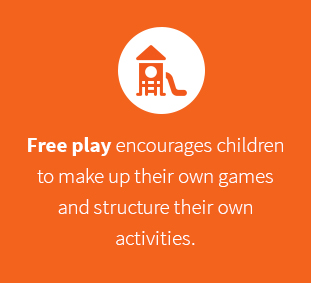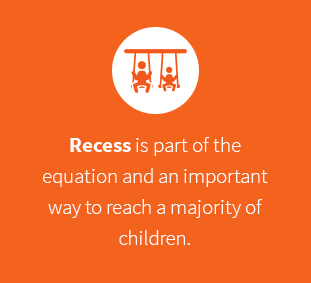Playtime for children is a fundamental part of our early years. Many parents and educators see playtime as a way for children to have fun and enjoy their time as kids. However, research is increasingly showing that this early experience can have a profound, positive impact that can last well into a child’s adult life.
There are many benefits of play for children. Playtime, recess and time in the playground give children a chance to move around, interact with other children, extended their skills, learn new things and work on physical, social, emotional and sensory development.
Read the full article or jump to a specific section:
Experts sometimes divide play into two categories: structured play and free play. Children often get quite a bit of structured playtime. Structured playtime refers to play which is supervised and organized or led by adults. Children get structured playtime through books, games, classroom activities, supervised play at home, and more. Examples of structured play include family board game nights, video games played together, and educational games suggested and led by a teacher. Each time a child is engaged in a game or other play activity led by an adult this is structured play.
Free play, on the other hand, refers to time children spend engaging in supervised creative and play exercises without specific instructions or initiation from adults – unless, of course, it pertains to safety. Playtime on a playground and recess are two good examples of free playtime. Adult supervision is present, but adults provide less structure for the playtime in these situations. It is up to children to decide what to do and what order to attempt different activities within the rules and guidelines of the playground.
There are benefits and drawbacks to each type of play. Structured play can be organized in such a way that it helps children learn specific skills and abilities. For example, educators can set up play stations with math and reading games to teach children math and language skills.
Structured play can also ensure children have lots of encouragement and guidance. If some kids struggle to engage with others or have a hard time taking part, the active involvement of a parent or teacher can address this challenge. On the other hand, it can result in less creativity. Free play can encourage more creativity and dynamic exchange among students.
One of the most common forms of free play children get is through time on the playground and time at recess while closely supervised by playground monitors or teachers. It is hard to overstate the importance of recess for childhood development or to overemphasize how rare this form of play is getting. Only about 40% of schools in Chicago have recess and many schools are considering reducing or eliminating it.
Taking away free play is a serious problem and can negatively affect children. Without recess, children do not have access to the many benefits of this type of play. They may have less room to develop their creativity, solve their problems, or interact with students they do not usually encounter in their classrooms. There are also a number of very important benefits of recess and playgrounds that children may miss without free play.
Well-supervised free play can have a number of benefits for children, including:
One of the benefits of play without a lot of structure is that children are encouraged to think for themselves and to come up with creative ideas. Without an adult telling them the rules of the game, or how to play, kids are free to come up with their own ideas and practice problem-solving. For example, if a playground activity only has spots for two children and three children are trying to play together, an instructor may come up with a resolution in structured play. In free play, children may need to develop a unique solution, such as having one child act as a narrator for a play scene they are acting out. Since children in free play might not turn to an adult for help, they need to start thinking of ways to resolve challenges they face on their own. This encourages children to learn and grow on their own, but close supervision allows an adult to intervene if any of the solutions they come up with violate playground safety rules or guidelines.
While structured play has clear rules and usually a reward system to encourage competition, free play encourages children to develop these rules and rewards themselves; children are free to create their own rules and games. Instead of using a slide as a slide, for example, they can create their own game involving imaginary play. The slide can become a fortress or a tower in a castle and the children go down the slide when they need to defend their fortress from an invading dragon.
One of the ways child’s play encourages creativity is by asking children to call upon past experiences and use them in new ways. If a child has learned in the classroom to make friends by asking questions, for example, they may start an interaction with a new player on the playground by asking questions. This thinking outside the box encourages children to build on their experiences. As they learn this skill, they learn to adapt creativity to a variety of environments, including the classroom.
Without structured activities defined by adults, children have to work together to resolve issues and to play together. With structured play, parents and other adults may be encouraging children to cooperate and get along. Without this parental input, children have to decide on their own how to cooperate and how to work together. Whether they’re trying to learn how to climb the side of a climber or figure out how to make an activity station work, without adult input, children tend to pull together to come up with ideas. Of course, a supervising adult can step in to remind children of playground guidelines and make sure that everyone stays safe.
In structured play, parents or adults are the leaders. In free play, children need to take turns being the leader or divide up leadership roles as needed. Whether that means determining what a fair rule is or playing referee, leaders are created on the playground.
Free play also encourages leadership by developing emotional intelligence and by helping children see the importance of communication to social influence. If kids want to play with others on the playground, they need to be able to communicate their ideas for games and entice others to see the rules their way. This can help children learn how to lead by example and communicate effectively.

One of the benefits of outdoor play and recess is that it allows children to get exercise and enjoy being active. Children often have higher energy for many reasons. Younger children may have higher energy, which can affect their ability to focus on activities important for their cognitive development if they do not have the chance to burn it off. Supervised free play gives them an outlet for this energy so that they can better focus on other, less active learning activities.
Children spend considerable time sitting in the car, sitting in class, playing video games and engaging in other sedentary tasks. In one study, children between the ages of 6 and 11 were found to spend more than 40% of their time in sedentary activities. A CDC study found that just 12.37% of high school students were taking part in intensive physical exercise at least three times a week.
This can be a serious concern since a sedentary lifestyle is linked to many health issues. Children who watch at least three hours of television a day have a 65% higher risk of obesity. Free play and time outdoors on the playground encourage children to move around and to get exercise. According to the American Academy of Pediatrics (AAP), 60 minutes of activity daily can reduce the risk of childhood obesity.
A study from the University of Colorado examined both structured and free play and concluded that children who engaged in more unstructured play had more advanced self-directed executive function. This function allows for organization, initiation of activities, planning, the ability to move between activities, and other tasks we usually associate with independence. Children who spent more time in structured play had less finely honed levels of this type of skill.

Research on animals has found that periods of play and exploration increase the amount of BDNF (brain-derived neurotrophic factor), which encourages the maintenance and growth of brain cells. While similar tests are not possible on humans, researchers concluded that the tests show the importance of play for human cognitive and brain development. About 75% of brain development happens between infancy and age 20, and play can encourage strong cognitive development by promoting the connections between nerve cells in the brain to form.
Bullying and aggression are a serious concern on playgrounds, with as many as one in three students reporting being bullied at some point in their school careers. Free play may help reduce instances of bullying, as some schools have discovered. One school, Swanson Primary School, saw a decline in bullying, timeout incidents and problems after eliminating rules during recess. According to school authorities, students became more engaged in play and less bored, causing them to act out less. While free play has been shown to lead to less instances of bullying, teachers and guardians should still keep a close eye on children during playtime to intervene in any cases of bullying.
During the childhood years, the frontal lobe portion of the brain develops as children take risks and see the consequences. In structured play, children may not be taking many risks, but in free play on the playground, kids have to make more decisions and then accept the consequences. If a child struggles while trying a too-ambitious piece of playground equipment, they can learn from this experience and see how their actions lead to results. Over time, a child can learn to take responsibility once they see the connection between their actions and the outcomes.
While many types of play and activity can be beneficial to children, free play can offer a number of tangible benefits by providing kids more freedom to learn and grow. Free play does not mean children are unsupervised.
During all free play activities, adults should closely watch over children and step in as needed. However, children initiate activities and are allowed to choose their own solutions to problems as much as possible.
Playgrounds are an important area for free play. In many cases, children play on playgrounds at recess, where they can move away from structured classroom time for a while. When parents and caregivers take children to a playground outside of school hours, they give children a chance to pick their own activities and pursue their own play experiences.
Children learn essential skills on the playground they cannot learn easily in other places. Many of these skills are ones that they will need later in life, and will build upon as they grow:
Playgrounds provide a unique opportunity for play because they provide a space where children can engage in unstructured play while also being supervised by adults nearby. Playgrounds also offer some structure. Playgrounds like the Rise Above structure have recognizable elements such as decks, slides and ladders. Children know what to do with these and have some idea how to play on these pieces of equipment. At the same time, the playground is open-ended enough to allow children to find unique ways to play. Kids can pretend the climbers are a mountain ridge, for example, and the decks are a tower.
Playgrounds are great because they can offer both structured and free play. Children can play on a playground like the Metro Station on their own, or educators and parents can create groups of children on the playground and lead kids through stations with more structured activities.
As the American Academy of Pediatrics claims, play is fundamental for children’s development. Both structured and unstructured play have important places in childhood.

Some parents and schools believe in free play on playgrounds, where children are allowed to determine the length of play and activities. This helps give children free reign to adapt any activities they wish. Others instill structured play and report it can improve playground experiences and participation.
Some schools emphasize the importance of structured play in helping children with their development. Structured play encourages children to learn skills that they may not have developed with activities chosen during free play. Games centered around math, for example, help children learn necessary math skills, even if a child has not learned to appreciate that subject yet. Students in structured play cannot opt out of specific games or activities as easily, which means they learn skills that, on their own, they might not have mastered.
Studies have also shown some big benefits to structured play. One study of schools with a more structured recess found 43% less exclusion and bullying and a 34% fewer number of minutes in getting children to focus back on work after recess. The same study found that schools with structured recess time had 43% more of recess time engaged in physical exercise compared with other recess structures.
Supervised free play, on the other hand, allows children to explore areas where they are already strong and things they genuinely enjoy, or areas of interest to them that they have yet to experience. A child who loves music, for example, may naturally gravitate towards activity panels on a playground where he or she can make music. Since free play is less structured, a child can develop their own rules and can create their own games or without being unduly influenced by our ideas of what they could or should be doing. Doctors Robert Murray and Catherine Ramstetter, writing for the American Academy of Pediatrics, concluded that free play is especially beneficial for a child’s creativity, health, and development.
Whether you believe in the importance of play in child development through structured or unstructured play, there is little doubt that both types of play have a place in a child’s life.
If you have a playground, you have the opportunity to create a space for play that allows for both supervised free and structured play. You can ensure your playground helps kids develop as much as possible by encouraging both types of play. You can do this by:
If you would like to create a playground where play is encouraged and where children have a number of opportunities to develop skills that will last them a lifetime, work with Playworld to create a quality playground where the focus is on having fun and learning on the playground. Playworld works with local sources and with childhood experts to build playgrounds designed to help children maximize growth and development. Playworld works with engineers and child-tests playground equipment to make sure kids are thrilled to play on our playgrounds.
We take safety very seriously. Each piece of equipment from Playworld is carefully tested and made from the highest-grade materials for durability and safety. To protect your child’s future, our equipment is 99.9999% free of PVC (Polyvinyl chloride) and we recycle 95% of waste.
Since 1971, we have been serving communities, schools, places of worship, and other organizations. Groups trust us because we make innovative and quality playground equipment that kids love. Educators love us because we build playgrounds designed to encourage sensory, cognitive, physical, emotional, and social development.
If you want kids to benefit from supervised free play and structured play, start planning your playground today. We can help with the design, ordering, and even the financing of your playground. Browse our playgrounds to start designing your ideal play area today.